HEAVEN AND(?) SOME HELL
The Blueberry Capital
A few turns after Exit 38 on New Jersey’s Garden State Parkway and I, a blueberry nut, soon entered what a visit to Bristol, Virginia would be to a country music nut, what Tupelo, Mississippi would be to an Elvis Presley nut, what Springfield, Massachusetts would be to a basketball nut, what . . . A big, blue sign declares Hammonton, New Jersey the self-proclaimed “Blueberry Capital of the World.” Literally millions of pounds of blueberries are picked and then shipped from this region of New Jersey each summer.
A few more miles and a few more twist and turns through the New Jersey Pine Barrens brings you to Whitesbog, New Jersey, “the birthplace of the domesticated, highbush blueberry.”
Let’s parse that last accolade.
“Domesticated:” Blueberries are a native American fruit that up until the early part of the last century were harvested only from the wild. No one cultivated them! Then Elizabeth White, a cranberry grower in Whitesbog, teamed up with Dr. F. V. Coville of the USDA to study and improve the blueberry. Ms. White instructed her pickers to search out the best wild blueberry bushes, which were moved to her farm. Dr. Coville investigated the rather specific soils (such as those of the Pine Barrens) enjoyed by blueberries (such as those of the Pine Barrens), and further evaluated and bred Ms. White’s selections. And the rest is, as they say, history.
“Highbush:” A number of blueberry species exist but the large berries for fresh eating that you see on market shelves are highbush blueberries, botanically Vaccinium corymbosum. Canned blueberries are usually another species, lowbush, botanically V. angustifolium. Dr. Coville and subsequent breeders have mated these two species as well as a number of other species with the goal of producing the elusive perfect blueberry. (Elusive to blueberry breeders, not to me; I like just about all of them.)
New Blues
After passing field after field of cultivated blueberries alternating with dense woodland, I turned into the parking area of the Marucci Center for Blueberry and Cranberry Research & Extension to meet with USDA research geneticist Dr. Mark Ehlenfeldt.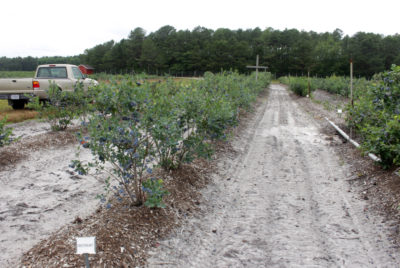
We looked at the fields of sandy soils formed into caterpillar-like, mulched mounds atop which were planted the bushes. We talked about the various species — V. constablaei, V. darrowii, V. ashei, in addition to the previously mentioned highbush and lowbush — that parented the various bushes.
Best of all, we plucked fruit to taste from many different varieties, some of which I grow and others of which are new to me. A few new ones that really stood out for me were:
•Sweetheart, for its medium-size that ripen early with excellent flavor
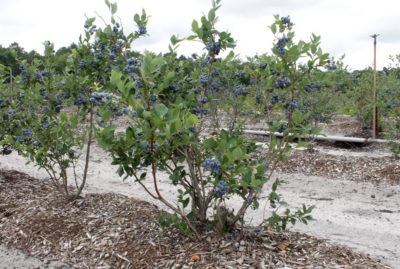
Sweetheart blueberry
•Cara’s Choice, also with excellent flavor, in addition to pinkish flowers; ripening mid-season
•Razz, a soft berry with a hint of raspberry flavor, and
•ARS 00-26, a small blueberry with a sweet, wild blueberry flavor.
Another blueberry variety that was very interesting, and perhaps tasty, was Nocturne, whose fruits, as they ripen, go from pink to bright red to blue black, making them very ornamental.
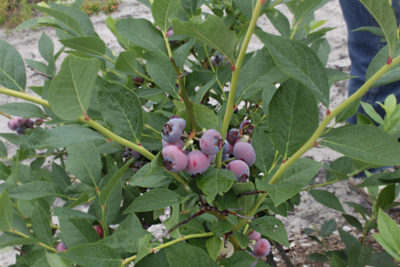
Pink Champagne
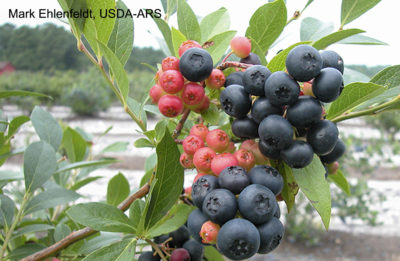
Nocturne blueberry
Nocturne fruits are supposed to have a unique flavor, sweet and somewhere between that of highbush and rabbiteye (V. ashei); they weren’t yet ripe so I wasn’t able to taste them. I did get a plant last year that is now ripening fruits so I can soon vouch, or not, for their flavor.
Two hours and many blueberries eaten later, I was on my way home.
Note: Not all the varieties mentioned are currently commercially available.
Beatlemania — I Hope Not
On a negative note, I saw here today (June 29th) the first Japanese beetles of the season, three on some grape leaves and four on some black raspberry fruits. I could just throw up my hands and brace myself for the few weeks of attack. Spraying pesticides is not an option; the beetles feed on hundreds of species. I’d have to spray just about everything here, including fruits ready to harvest, which is a no-no.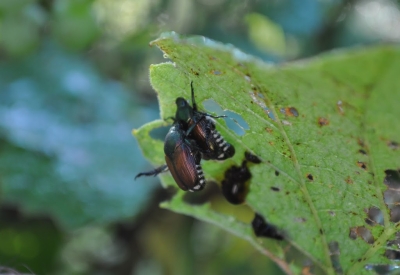
I’m hoping the beetles take the same tack they have for the past two years, a few showing up, and then, shortly thereafter, doing about faces and leaving for the season. I have no idea why.
Worst case scenario is that they descend in hordes, in which case I’ll remind myself that plants can tolerate a certain amount of damage, with remaining leaf area working harder to compensate for leaf area chewed away. Also, the beetles make their exit in August.
I pulled the seven beetles I saw off their respective plants, threw them on the ground, and stomped on them. Not out of anger or meanness, though. Beetle feeding attracts more beetles. I didn’t want any invitations for their friends and relatives.


I believe there is a new BT for adult beetles. Sold at gardens Alive as beetle juice. Let me know your thoughts. Never used it.
I had never heard of it but looked up some information. It seems to have potential but is very expensive. Beetle populations have been diminishing around here so I’ll never have to purchase the stuff, I hope.
Here in KC MO area the Japanese beetles have hit my garden hard. Last year I had 1 or 2 this year I’ve not had one rose nor a canna flower as they have eaten them all.
I have a peanut butter jar 1/4 full of water, splash of vinegar & a squirt of Dawn soap as my arsenal. Early morning & late evening for 2 months I head out & had one rosebud glimmering with them-25! I gently bend the branch into the jar & shake it & off they fall in. I have a city acre & near a hedgerow of arborvitae the ground was moving, I thought it was a mole moving the ground. NO! The grass was full of beetles like ants! Creeped me out!
I think my problem was we had a mole, vole & skunk problem this spring & I used MoleMax to get rid of them, I may have shot myself in the foot since they eat grubs.
I’m planning on making netting covers next year for the plants which take away from their beauty but for my sanity mostly. I think you’re right about them moving on as Aug nears, only had one today.
Love your blog posts & book on no weeds. I love not turning over my soil. My husband bought me a new shovel for Christmas last year & haven’t used it! I do raised beds since Mel Barthomew was on TV & really hated digging the beds but now I rarely have weeds. Thank you! Only thing is I rarely work in my garden now, ha!
Hi Just wondering if you had a chance to try Nocturne and how it tasted. Great posts.
Chris
Haven’t tried it yet.
Have you tried it YET? I’m considering getting some this spring.
Nocturne should fruit for me this coming season.
Greetings, Its 2021. Last year I purchased 2 Nocturne Blueberries bushes. I came across your website and wonders if you have as yet had a Nocturne crop and how did the plants perform for you. I’m in western NC and have 2 other Blueberry varieties.
BTW: I’m hoping that Milky Spore Granule will be the solution to my Japanese Beetle problem, which is severe. This summer will tell…
Nocturne has been doing very well for me.
Linda, my Nocturne bushes have been growing very well for me, have presently set more flowers than any of my other varieties, and I really enjoy the slightly more complex flavor of the fruit. As an added bonus they look great in the fall!